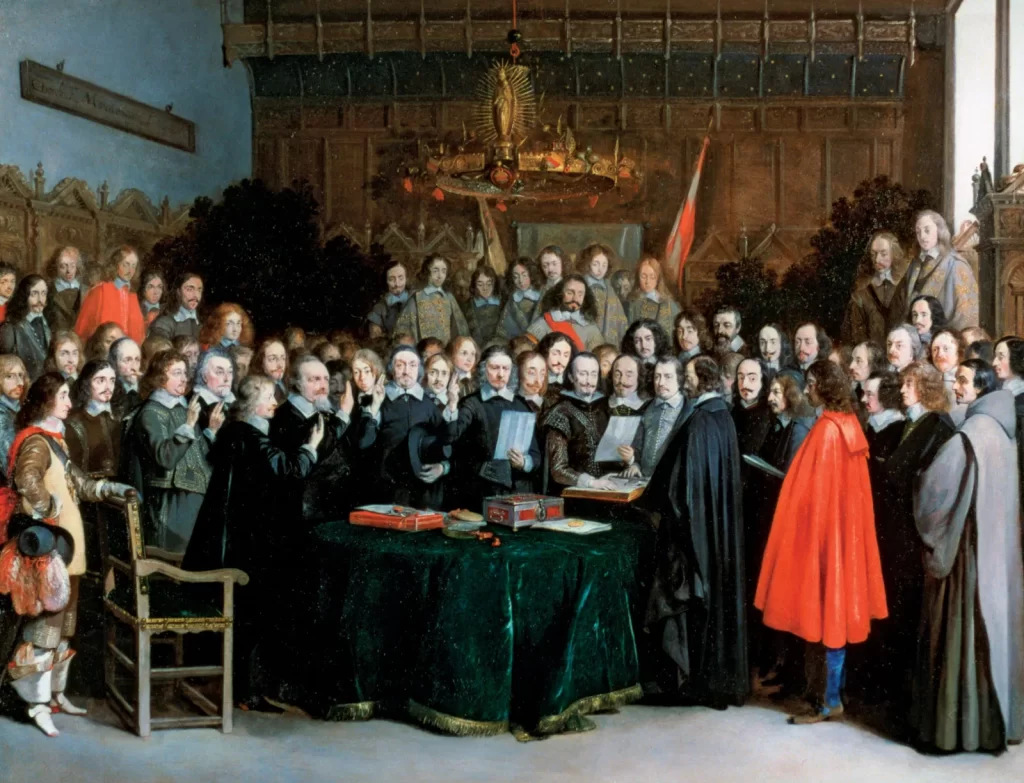The Westphalia Treaties of 1648, also known as the Peace of Westphalia is the collective name for two peace treaties signed in October 1648 in the Westphalian cities of Osnabrück and Münster. The Treaty ended the Thirty Years’ War, which was one of the longest and most destructive conflicts in European history, lasting from 1618 to 1648. It also brought peace to the Holy Roman Empire, closing a calamitous period of European history that killed approximately eight million people.
Background
Europe had been battered by both the Thirty Years’ War and the Eighty Years’ War, exacting a heavy toll on money and lives. The Eighty Years’ War was a prolonged struggle for the independence of the Protestant-majority Dutch Republic (the modern Netherlands), supported by Protestant-majority England, against Catholic-dominated Spain and Portugal.
The Thirty Years’ War was the most deadly of the European wars of religion, centered on the Holy Roman Empire. The war, which developed into four phases, included a large number of domestic and foreign players, siding either with the Catholic League or the Protestant Union (later Heilbronn League).
The Peace of Prague (1635) ended most religious aspects of the war, and the French–Habsburg rivalry took over prominence. With almost 8 million dead in the Thirty Years’ War alone and decades of constant warfare, the need for peace became increasingly apparent.
Preliminary Negotiations
Before the Westphalia treaties, France and the Habsburg Emperor began peace negotiations in Cologne in 1636. These negotiations were initially blocked by Cardinal Richelieu of France, who insisted on the inclusion of all his allies, whether fully sovereign countries or states within the Holy Roman Empire.
In Hamburg, Sweden, France, and the Holy Roman Empire negotiated a preliminary peace in December 1641. They however all declared that the preparations of Cologne and the Treaty of Hamburg were preliminaries of an overall peace agreement.
Negotiations
The Westphalia treaty negotiation process was lengthy and complex. Talks took place in two cities: Münster and Osnabrück because each side wanted to meet on territory under its control. The peace negotiations had no exact beginning or end because the 109 delegations representing the belligerent states never met in a plenary session. Instead, various delegations arrived between 1643 and 1646 and left between 1647 and 1649. The largest number of diplomats were present between January 1646 and July 1647.
In Münster, negotiations took place between the Holy Roman Empire and France along with their respective allies. Also there was a negotiation between the Dutch Republic and Spain who on 30 January 1648 signed a peace treaty ending the Eighty Years’ War that was not part of the Peace of Westphalia. Sweden, along with its allies negotiated with the Holy Roman Empire in Osnabrück.
Read More:
- Woodrow Wilson’s 14-Point Agenda
- Why do Africans have European Surnames?
- Notorious Serial Killers in Nigeria’s History
Agreements
The power asserted by Ferdinand III was stripped from him and returned to the rulers of the Imperial States. The rulers of the Imperial States could again choose their official religions. Catholics and Protestants were redefined as equal before the law, and Calvinism was given legal recognition as an official religion. The independence of the Dutch Republic, which practiced religious toleration, also provided a haven for European Jews.
Tenets
The main tenets of the Peace of Westphalia were:
- All parties would recognize the Peace of Augsburg of 1555, in which each prince had the right to determine the religion of his state. However, the subjects were no longer forced to follow the conversion of their ruler. Rulers were allowed to choose between Catholicism, Lutheranism, or Calvinism.
- 1 January 1624 was defined as the normative date for determining the dominant religion of a state. All ecclesiastical property was to be restored to the condition of 1624. Christians living in principalities where their denomination was not the established church were guaranteed the right to practice their faith in private and public during allotted hours.
- France and Sweden were recognized as guarantors of the imperial constitution with a right to intercede
Aftermath and Legacy
As earlier stated, The Westphalia treaties ended the Thirty Years’ War in the Holy Roman Empire, with the Habsburgs (rulers of Austria and Spain) and their Catholic allies on one side, battling the Protestant powers (Sweden and certain Holy Roman principalities) allied with France which was though Catholic, strongly anti-Habsburg under King Louis XIV.
Fighting however continued between France and Spain until the Treaty of the Pyrenees in 1659. The Dutch-Portuguese War that had begun during the Iberian Union between Spain and Portugal, as part of the Eighty Years’ War, went on until 1663.
Some scholars of international relations have identified the Peace of Westphalia as the origin of principles crucial to modern international relations, including the inviolability of borders and non-interference in the domestic affairs of sovereign states. This system became known in the literature as Westphalian sovereignty.


